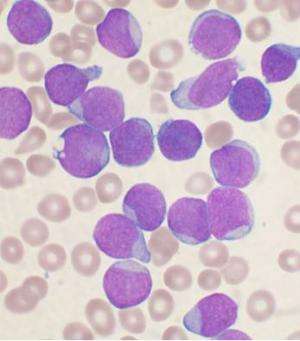Breakthrough in cancer cell screening advances personalised treatment of childhood leukaemia

Researchers at Newcastle University have been able to accurately predict how children whose cancer returns after treatment for leukaemia are likely to respond to further treatment.
The findings, from the largest study of its kind, will allow doctors to analyse the genetic profile of cancer cells to personalise treatment and improve survival rates.
Thanks to research, up to nine in 10 children diagnosed with acute lymphoblastic leukaemia, the most common form of childhood cancer, will now achieve a long-term cure. The prognosis is much poorer for those children whose disease relapses, however, with fewer than six in 10 children surviving longer than five years.
Genetic faults within developing white blood cells kick-start and drive leukaemia growth. The types and combinations of genetic errors are known to influence whether a child is likely to respond well to initial treatment, which in turn affects whether they have a good or poor chance of survival. Genetic screening is already used to tailor treatment at diagnosis, ensuring children receive the most appropriate intensity of chemotherapy. Until now it has been less well understood how these 'genetic markers' can be used to guide treatment if the leukaemia comes back.
The Newcastle scientists, funded by the blood cancer charity Bloodwise, analysed leukaemia cells from 427 children treated for relapsed acute lymphoblastic leukaemia between 2003 and 2013. They used a variety of genetic tests including fluorescence in situ hybridization (FISH), where glowing tags are bound to sequences of DNA within the cancer cells, allowing scientists to view specific genetic changes under a microscope.
Currently, children with relapsed leukaemia are grouped by whether they were at a standard or high risk of a poor outcome, based on factors such as how long the child had been in remission and if leukaemia cells were present in the bone marrow at the time of relapse. Patients currently deemed to be high risk under these criteria will undergo a gruelling stem cell transplant, while standard risk patients are normally treated with further chemotherapy.
Patients whose leukaemia returns a long time after treatment has ended have, up until now, been thought to have a good chance of survival. These patients typically receive less intense chemotherapy than patients thought to be at higher risk. The team, led by Professor Anthony Moorman and Dr Julie Irving from the Northern Institute for Cancer Research at Newcastle University found that children in the standard risk group who, at the time of relapse, had one or more 'high risk' genetic abnormalities responded poorly to chemotherapy.
In addition, the researchers discovered abnormalities in a number of genes (e.g. TP53, NR3C1, BTG1 and NRAS), which not only provided additional information about how and why these children responded poorly to current therapy, but also provided useful insights into how future children with similar gene defects might be more efficiently treated. For example, children with a defect in one of the RAS genes may benefit from a new drug called a 'MEK inhibitor', which specifically kills cells with a faulty RAS gene.
The study is published in the prestigious journal Blood.
Anthony Moorman, Professor of Genetic Epidemiology, who co-leads the Leukaemia Research Cytogenetics Group at Newcastle University, said: "Current methods used to guide treatment for relapsed leukaemia are not accurate enough, with some children believed to have a good chance of survival actually responding very poorly to chemotherapy. Screening patients at relapse for key genetic abnormalities that influence outcome will ensure that treatment can be personalised, thereby improving their chances of survival."
The researchers also identified a large group of children with 'low risk' genetic faults. When these children also had good clinical risk factors – such as a long first remission – their response to standard chemotherapy was very good and they could be spared a stem cell transplant.
Dr Alasdair Rankin, Research Director at Bloodwise, said: "The outlook for children who relapse is generally poor and so more effective treatment approaches are desperately needed. These findings represent a significant step forward in the development of personalised treatment for these patients. Further research will be needed to test whether tailoring treatment for relapsed disease based on genetic factors does actually improve survival rates."
More information: T. McKerrell et al. Development and validation of a comprehensive genomic diagnostic tool for myeloid malignancies, Blood (2016). DOI: 10.1182/blood-2015-11-683334


















